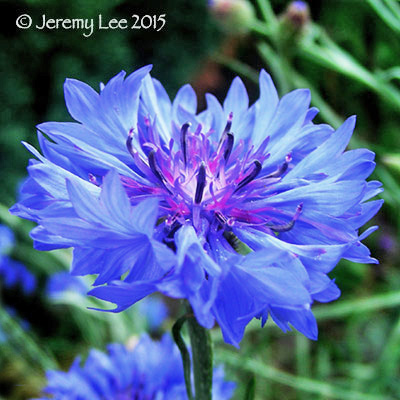
 |
|
Scientific Classifications explained » Amphibians » Ants » Aphids » Bees » Beetles » Birds » Bugs » Butterflies » Caterpillars » Damselflies » Dragonflies » Earwigs » Flies » Frog/Leafhoppers » Fungi » Galls » Grasshoppers » Harvestmen » Hoverflies » Lacewings » Ladybirds » Leaf Mines » Lichens » Mammals » Millipedes » Mosses » Moths » Sawflies » Slugs » Snails » Spiders » Trees & Shrubs » Wasps » Wild Flowers » Woodlice » Postboxes |
UK Nature > Wild Flowers > Blue & Purple Wild Flowers > Centaurea cyanus

Scientific Name: Centaurea cyanus Common Name: Cornflower Centaurea cyanus, more commonly known as Cornflower, is an annual flowering plant in the family Asteraceae, native to Europe. It is an annual plant growing to 40 - 90 cm tall, with grey-green branched stems. The leaves are lanceolate, 1 - 4 cm long. The flowers are most commonly an intense blue colour, produced in flowerheads 1.5 - 3 cm in diameter, with a ring of a few large, spreading ray florets surrounding a central cluster of disc florets. Its leaves are heart-shaped with rounded teeth and are usually hairless. It has 2 slender bracts, 6 sepals, spear shaped and lobed at the base and 5 overlapping petals with a backward-pointing spur. The plant is an early nectar source for butterflies and is the larval host plant for a range of Fritillary butterflies, including the Small Pearl-Bordered (Boloria selene), the Pearl-Bordered (Boloria euphrosyne) and the Silver-Washed (Argynnis paphia). |
|

https://www.uknature.co.uk is a website dedicated to showing the immense diversity of UK nature and wildlife. Our vast range of habitats, from lowland arable to snow covered mountains, from storm-ravaged coastlines to peaceful inland freshwater lakes and rivers, from dry, sandy heaths to deciduous and coniferous forests, all these habitats contribute to the abundance of UK nature. We have wild birds in huge numbers either residing or visiting our shores (597 recorded species as at July 2013) and we must also not forget the humble back garden with its grass lawns, flower beds filled with nectar rich flowers, shrubs and trees, all designed to attract huge numbers of insects such as bees, moths, butterflies and hoverflies; and finally the small ponds which provide safe havens for frogs, toads, newts and even slow worms and grass snakes. www.uknature.co.uk is the showcase for my personal passion, photographing uknature in all its glory. I sincerely hope you all enjoy the fruits of my labours. This site and all images contained therein is © Jeremy Lee 2004 - 2025. All Rights Reserved. Site design by Jeremy Lee. Site development & IT Support by Stuart Lee. |